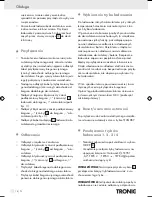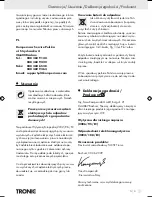
7
GB
Introduction / Safety
16
„–“-Pole quick-contact terminal (black), incl.
black fixing screw
Q
Technical Data
Input voltage:
220 - 240 V ~ 50 / 60 Hz
Power consumption:
60 W
Reverse current*:
< 5 mA (no AC input)
Nominal output voltage: 6 V
/ 12 V
Nominal output current: 0.8 A / 3.8 A
Charging voltage:
7.3 V or 14.4 V or 14.7 V
Charging current:
0.8 A ± 10 %
3.8 A ± 10 %
Battery type:
6 V lead-acid battery
1.2 Ah - 14 Ah
12 V lead-acid battery
1.2 Ah - 120 Ah
Housing protection type: IP 65 (dust-proof,
water-proof)
Safety class:
II /
* = Return current is the current used by the
charging station battery, when no mains
current is connected.
Q
Safety
Safety information
DAngEr!
Avoid danger to life and limbs
caused by improper use!
CAUTIOn! Do not operate the appliance
with a damaged cable, power cord or
plug.
A damaged power cord causes danger
to life by electric shock.
J
If damaged, have the power cord repaired by
authorised and trained technicians only! Please
contact the service department for your country!
J
PrOTECT yOUrSElF FrOM
An ElECTrIC ShOCk!
When
connecting the charging station, use
a screwdriver and a spanner with an insulated
handle!
J
DAngEr OF ElECTrIC ShOCk!
Do not
operate the vehicle if you are charging a battery
while it is still in the vehicle! Switch off the igni-
tion and park the vehicle. Apply the parking
brake (e.g. in cars) or secure with a mooring
rope (e.g. electric boat)!
J
DAngEr OF ElECTrIC ShOCk!
Disconnect
the battery charger from the mains before you
make or break the connections to the battery.
- First connect the clamp that is not connected
to vehicle bodywork, then connect the other
clamp to the vehicle bodywork at a point
away from the battery and the fuel line. After
this is done, you can connect the battery
charger to the mains.
- After charging, disconnect the battery charg-
er from the mains. Then disconnect the clamp
attached to the vehicle bodywork before you
disconnect the clamp from the battery.
J
DAngEr OF ElECTrIC ShOCk!
Handle
the connecting cables („–“ and „+“) by their
insulated areas only!
J
DAngEr OF ElECTrIC ShOCk!
Ensure
that there is complete protection from moisture
at the connections to the battery and at the
mains outlet socket!
J
DAngEr OF ElECTrIC ShOCk!
Carry out
the mounting, maintenance and cleaning of the
battery charger only when it is disconnected
from mains!
J
DAngEr OF ElECTrIC ShOCk!
After
completion of the charging and maintenance
charging process on a battery mounted in a
vehicle, first disconnect the negative connection
cable (black) of the battery charger from the
negative terminal of the battery.
J
Do not leave small children
unattended with the battery
charger!
Children are too young
to assess the possible dangers associated with
electrical devices. Children should be super-
vised in order to ensure that they do not play
with the device.
J
Children or persons who lack the knowledge or
experience to use the device or whose physical,
sensory or intellectual capacities are limited
must never be allowed to use the device without
33211_Battery charger_Content_LB4.indd 7
15.06.09 12:41
Summary of Contents for T4X SE
Page 3: ...A 1 3 4 5 2 10 6 7 8 12 B C 16 9 11 12 15 14 13 ...
Page 21: ...22 ...
Page 31: ...32 ...
Page 41: ...42 ...
Page 67: ...68 ...







































